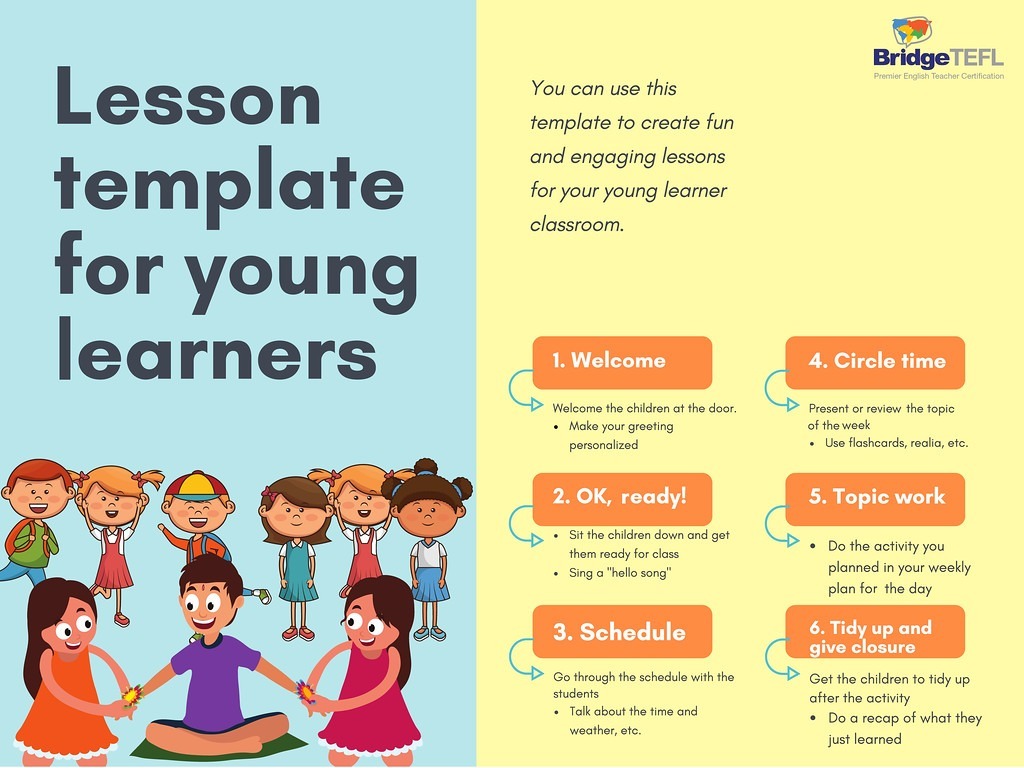If you teach English to children, or plan to, student behavior (i.e. ESL classroom management) is probably something you’ve at best thought about– and at worst, struggled with. When it comes to how to teach kids English, routines are key (and downtime is dangerous!). This guide provides strategies for organizing and managing your class that you can use from the very first day, such as classroom routines for young learners, consistent prompts between activities, clear rules and consequences, and starting out strict.
If you’re new to teaching, you’ll want to get initial training and qualification with a TEFL certificate. You can explore our online TEFL courses to get started!
What is the importance of classroom routines?
Classroom routines have several important benefits within the young learners/teens learning environment. When used correctly, routines:
- Keep students’ from getting distracted or bored during downtown between activities.
- Prevent students from having to ask “What are we doing?” or “What are we doing next?”
- Help students’ listening and comprehension skills.
- Allow learners to know what to expect in class.
- Provide students with opportunities to practice all four aspects of the language (listening, reading, writing, and speaking).
How do classroom routines affect ESL student behavior?
Classroom routines affect learners’ behavior in positive ways! Routines that are well-crafted and consistently adhered to allow the teacher to build a comfortable learning environment for young learners.
As a result of routines, students are much more likely to come prepared to class, understand what is happening throughout a lesson, and maintain their focus during instruction.
Consider a classroom environment (or any environment) where you’re unsure of what’s going on and how you are expected to act. You might, naturally, be inclined to act out– not out of any sense of defiance– but rather out of confusion or uncertainty.
Watch a video from the BridgeTEFL Teaching English to Teenagers course that demonstrates problems that arise when the teacher does not have an effective class routine:
Implementing effective classroom routines is one of the most efficient ESL classroom management techniques to avoid such scenarios. You’ll notice that after a routine has been done two or three times, students will begin to seamlessly transition between classroom activities with minimal, if any, disruptions or confusion.
What are some classroom routines and lesson structures? How do you create a classroom routine?
Classroom routines and lesson structures are the elements of your classroom management and lesson planning that become a consistent part of your classes. They allow young learners to develop familiarity with your practice.
Classroom Routines and Cues
Routines, or the structured activities you do in your class every day, are a valuable part of classroom management and effective learning.
This template from the BridgeTEFL Teaching English to Young Learners course provides an example of a daily routine for a class of children.

The six steps in this lesson would be repeated by the teacher every day, but the activities such as “circle time” and “topic work” are tailored according to the day’s lesson plan. The first two steps are done at the beginning of class, and are the “opening routine.” Step 6 is done at the end of every class and is the “closing routine.”
It’s also useful to have some sort of a signal, whether verbal or visual, to indicate the transition into each activity in your routine. For example, as a teacher in China, I teach large classes of 4th and 5th graders (my students are between nine- and eleven-years-old). Every classroom at my school is equipped with a computer, a projector, and a screen, and we use PowerPoint presentations to teach, which is the norm in China.
My morning classroom routine with my students is as follows.
- To begin my classes, I signal the students by saying, “Good morning, class. Welcome back to English class. This is the (first, second, third, etc.) week of the semester,” while giving a polite bow, as is customary in Chinese classrooms.
- Then I state and mime my five rules, while having students repeat them back to me.
- Next, I ask, “How are you?” and this signal prepares my students for the next routine, in which they will each answer this question individually. This activity shows I care about them, discreetly allows them to practice the language, and even gives quieter students an effective opportunity to participate in class.
- Then we go over the day’s date. For a visual cue, I go to the front of the class, raise my hand and point at the calendar. I instruct a student to write the full date on the board. The rest of the class then tries to fix any mistakes, in spelling, order, etc.
- To signal this new activity is starting, I project an image on the board, via PowerPoint, that shows a cartoon of a teacher and students conversing. (The same image is used each week, allowing the students to develop an association between the image and the activity.) I ask each student the same simple question, such as “What did you do yesterday?” or “What did you have for breakfast?” which helps to refresh that week or day’s vocabulary. This provides good repetition for correct grammar and pronunciation.
- Next, I point to the board, where I’ve written a breakdown of what we will do during the lesson, and we discuss what our ultimate goal or objective is, and how we will get there.
- When we’re done, I project an image on the board of the students’ textbook to signal students to take out their books to review the last night’s homework.
Of course, you’ll want to be sure to create routines and signals appropriate for your students’ age and proficiency level. Be patient early on and you will soon see the routines taking shape. Eventually, you won’t even have to say what routine it is time for.
Lesson Structures
A lesson structure is how you consistently administer your lessons (Step 5 in the graphic above). Generally speaking, you should aim to have your lessons follow the same order each time so that they have their own routine. Structuring lessons is an effective way of teaching new material to the students, makes the lesson simple for them to follow, and allows room for your creative variations.
Four Ps and One R
A common lesson structure is known as “Four Ps and One R,” which stands for Present, Practice, Produce, Review, and Prize.
In this lesson plan structure, the teacher presents new material and the students then practice it. Next, the students produce something meaningful from the new material, such as through a written or verbal activity using the new vocabulary term or grammar concept. Then, the class reviews the new material, and the teacher explains any mistakes. Lastly, the teacher may give an appropriate prize, such as stickers, candy, or movie time, for students who have behaved well throughout the class and actively participated in the day’s plans.
I aim to have all of my lessons follow this “Four Ps and One R” structure because it aids in classroom management if students know what to expect. For example, when a student recognizes that the class is currently doing the practice segment of a lesson, he or she will expect that they will soon be asked to move to the produce segment.
How do you use routines to interact with your students from the first day to manage student behavior?
An old teaching adage states that your students should never see you smile until Christmas time. But, I strongly disagree. The notion is that your students ought to understand your role as the authority figure in the classroom from day one. While there is some merit to that, there are better ways to approach the impression you give your students. It’s possible to strike a balance that enables discipline and fun!
Establish class rules
Come to class on day one with a set list of rules, guidelines, and/or standards that you want to see your young learners follow. Spend time discussing each one of these in detail. Involve students to provide visual examples of how to follow the rule and how to break the rule. This will be very useful for students of lower English proficiency, who may not understand, “stay in your seat,” but would better comprehend a role play in which a classmate stands up without permission.
Your rules should be written in simple enough terms for the entire class to understand, and posted somewhere visible in the room. Still, go over all of them briefly at the beginning of each lesson, as a reminder. My personal set of rules for my 4th and 5th-grade classes is as follows:
- Stay quiet
- Look at the teacher
- Listen to the teacher
- Stay in your seat
- Answer questions
Be clear about consequences
Of course, rules are meaningless without consequences! The consequences you use in your classroom should be in line with the policies of the school where you teach.
Such consequences can include a student having to stand up (a popular tactic in China), the student’s team losing points in a competitive game, or the student being sent to the office if misbehavior is excessive enough. If a student behaves very poorly or if misbehavior persists, it may be the school’s policy that you will contact the student’s parents.
If a student does not abide by a given rule, you can have a routine in place for that as well, using non-verbal cues. Non-verbal cues allow you to continue teaching without interruption while still getting the message across to your students. For example, these are the cues I use in my classes:
- I use a simple hand signal to let a student know to stop a behavior.
- I put a finger to my lips if a student speaks out of turn.
- I touch my ear when I need students to listen to me.
- I point at my eyes when I need them to look at me.
- I use a downward motion with an open palm when a student should be seated.
Start out strict
While managing student behavior in the classroom begins on day one, its success is dependent on your consistency in adhering to class rules and consequences throughout the term. My advice is to start the term out strict. By this I mean not to let your students get away with any kinds of misbehaviors and disruptions early on. The stricter you are from the onset, the more seriously your students will take your rules.
As the semester progresses, you can gradually allow more leniency if you feel the student or class deserves it. As you gain more experience in the classroom, you will quickly develop an understanding of how to handle the balance between being strict and being flexible.
How do I become a better classroom manager?
Few teachers would argue the importance of good classroom management in the ESL classroom, which begins the moment you and your students walk into class. Routines and lesson structures are extremely helpful in managing your young learners or teenagers, minimizing idle time and improving behavior by keeping student expectations clear.
Create a class routine and stick to it without fail, using non-verbal cues to move from activity to activity. You can also become a better classroom manager by having simple classroom rules and consequences in line with your school’s policies, and firmly adhering to them, especially in the beginning, when you’re setting the tone for the rest of the term.













